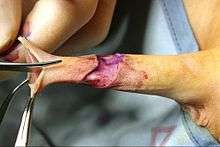Circumcision surgical procedure

The male circumcision surgical procedure may involve one of various devices such as the Circumplast, Gomco clamp, Plastibell, Mogen clamp and Shang ring.
With all these devices (except for the Shang ring), the same basic procedure is followed. First, the amount of foreskin to be removed is estimated. The foreskin is opened via the preputial orifice to reveal the glans underneath and ensure it is normal. The inner lining of the foreskin (preputial epithelium) is bluntly separated from its attachment to the glans. The device is placed (this sometimes requires a dorsal slit) and remains there until blood flow has stopped. Finally, the foreskin is amputated.[1] Sometimes, the frenulum band may need to be broken or crushed and cut from the corona near the urethra to ensure that the glans can be freely and completely exposed.[2]
Devices
Circumplast
With the Circumplast, once the glans is freed, the Circumplast is placed over the glans, and the foreskin is placed over the Circumplast. A ligature is then tied firmly around the foreskin and tightened into a groove in the Circumplast to achieve hemostasis. Foreskin distal to the ligature is excised and the handle is snapped off the Circumplast device. The Circumplast falls from the penis after the wound has healed, typically in four to six days.
Gomco clamp
With a Gomco clamp, the foreskin is dorsally crushed with a hemostat and then slit with scissors from the tip to the coronal sulcus. The foreskin is drawn over the bell shaped portion of the clamp and inserted through a hole in the base of the clamp. The clamp is tightened, "crushing the foreskin between the bell and the base plate." The crushed blood vessels provide hemostasis. The flared bottom of the bell fits tightly against the hole of the base plate, so the foreskin may be cut away with a scalpel from above the base plate.[3]
Plastibell

With the Plastibell, once the glans is freed, the Plastibell is placed over the glans, and the foreskin is placed over the Plastibell. A ligature is then tied firmly around the foreskin and tightened into a groove in the Plastibell to achieve hemostasis. Foreskin distal to the ligature is excised and the handle is snapped off the Plastibell device. The Plastibell falls from the penis after the wound has healed, typically in four to six days.[4]
Mogen clamp
With a Mogen clamp, the foreskin is pulled dorsally with a straight hemostat, and lifted. The Mogen clamp is then slid between the glans and hemostat, following the angle of the corona to "avoid removing excess skin ventrally and to obtain a superior cosmetic result" to Gomco or Plastibell circumcisions. The clamp is locked, and a scalpel is used to cut the skin from the flat (upper) side of the clamp. The clamp can be safely used by non-physician healthcare workers in resource-limited settings[5] [6][7]
References
- ↑ "Circumcision policy statement. American Academy of Pediatrics. Task Force on Circumcision". Pediatrics. 103 (3): 686–93. March 1999. doi:10.1542/peds.103.3.686. PMID 10049981.
- ↑ "Neonatal Circumcision: An Audiovisual Primer". Stanford School of Medicine.
- ↑ Peleg D, Steiner A (September 1998). "The Gomco circumcision: common problems and solutions". American Family Physician. 58 (4): 891–8. PMID 9767725.
- ↑ Barrie H, Huntingford PJ, Gough MH (July 1965). "The Plastibell Technique for Circumcison". British Medical Journal. 2 (5456): 273–5. doi:10.1136/bmj.2.5456.273. PMC 1845746
 . PMID 14310205.
. PMID 14310205. - ↑ Kankaka EN, Murungi T, Kigozi G, et al. Randomised trial of early infant circumcision performed by clinical officers and registered nurse midwives using the Mogen clamp in Rakai, Uganda. BJU Int. September 2016. doi:10.1111/bju.13589.
- ↑ Fowler, Grant C.; Pfenninger, John L. (2003). Pfenninger and Fowler's procedures for primary care. St. Louis: Mosby. ISBN 978-0-323-00506-7.
- ↑ Reynolds RD (July 1996). "Use of the Mogen clamp for neonatal circumcision". American Family Physician. 54 (1): 177–82. PMID 8677833.